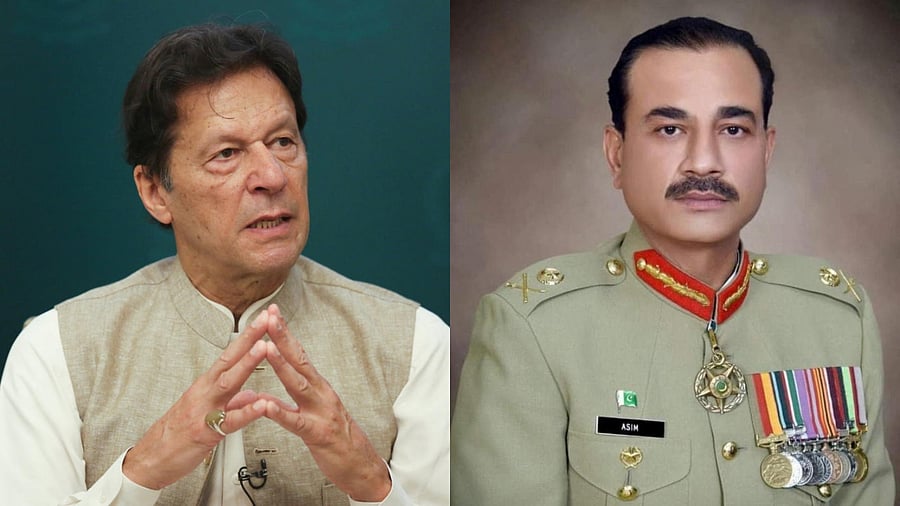
Imran Khan (L); General Asim Munir.
Credit: Reuters Photos
Nearly three years after Imran Khan's ouster as prime minister, the battle between him and Pakistan Army chief General Asim Munir continues unabated.
The most recent round played itself out last week at Islamabad's famous D-Chowk, the public square where for years politicians and their parties have gathered to protest either against each other or against the military. The ‘D’ in D-Chowk is beguiling, and many believe it stands for Democracy.
Khan won the popular vote in the February election, even though his Pakistan Tehreek-e-Insaf (PTI) was banned and he was thrown in jail. PTI candidates contested as independents but defeated many stalwarts in the Pakistan Muslim League (N). However, Khan’s democratic credentials are as illusory as democracy at D-Chowk.
Khan does not believe in parliamentary politics. As prime minister, he hardly attended National Assembly sessions. He believes it is beneath him to negotiate with politicians from other parties. He is a populist who believes he alone has the answers to Pakistan's problems. And, his appeal is nothing less than messianic.
Khan's quarrel is not with the Army or its dominance over Pakistan's politics, but with Munir, against whom he has a personal animus dating back to 2019, when he was prime minister and the latter was the ISI chief.
Munir clearly has the upper hand in this battle. The assembly of 50,000 people at D-Chowk on November 26 was broken up using brute force. Twelve is the official number of protestors killed. Prime Minister Shehbaz Sharif’s coalition government of the PML(N), the Pakistan People' Party, and other smaller parties, rushed to provide the gratuitous clarification that the firing was carried out by the police and not the Army, and that no live ammunition was used. But everyone in Pakistan knows who's calling the shots.
The debacle at D-Chowk for Khan has left the PTI in disarray. But what really was the plan of his ‘final call’ protest? Opposition political groups and their supporters gather at D-Chowk because they believe that holding a demonstration, camping for days and paralysing the capital, or maybe trying to overrun Parliament as Khan's supporters tried in 2014, is enough to overwhelm a government and make it step down. It has happened, but only when the Army takes the side of the protestors.
Khan knows that better than anyone else. In 2014, in his attempt to unseat the Nawaz Sharif government, he said a "third umpire" would raise his finger and send Nawaz Sharif packing. No one needed to be told who he meant, and it was not the Supreme Court. Khan's appeal was dismissed at the time.
However, in 2017, his threat to paralyse the capital got the court to begin hearing his petition alleging corruption against Nawaz Sharif, which finally led to what is widely known as the ‘judicial coup’ that unseated Nawaz Sharif. By then, the government was already weakened by a protest at D-Chowk by the Tehreek-e-Labbaik Pakistan, a Barelvi group, which demanded that some ‘blasphemous’ changes to the constitution be removed. The protest ended after the Army mediated an agreement with the government.
Last month, Pakistan's parliament passed a Bill to extend the Army chief's tenure from three to five years, giving Munir until 2028 in the job. How many more times can Khan take on Munir in the next four years? Will the Army chief be able to wear out the politician to a point of no return? And, where does that leave an economically ruined Pakistan?
The other side of the coin is that with most of Pakistan on Khan's side, Munir's battle with Khan has eroded the compact, carefully nurtured over years, between the public and the military as an institution.
Pakistan army chiefs crave public popularity. But if Khan's supporters disliked Munir from the get-go, he has become more unpopular with each attempt to suppress the politician. His move to go for broke against Khan is also said to have created divisions within the Army itself.
Munir has had to sack at least one serving lieutenant general over the May 9, 2023 events. A former ISI chief is being tried for his role. Families of several high-ranking officials in all three services have openly sided with Khan; some family members have been arrested. Several mid-ranking officials and many others are said to be Khan sympathisers.
The last chief seen as eroding public faith in the military and damaging the institution was General Pervez Musharraf. He was the one to blink in his battle with Chief Justice Iftikhar Muhammad Chaudhry. It was left to his successor, General Ashfaq Parvez Kayani, to repair the damage to the institution, the exalted term that the Pakistan military uses to describe itself.
The last Pakistani politician who succeeded in touching a popular chord and came close to Khan's levels of popularity was Zulfikar Ali Bhutto. It did not end well for him. To some, the political unrest recalls the situation in 1971. Imran Khan's popularity is being compared with the love for Sheikh Mujibur Rahman in 1971, the Army's repression to the mistakes it made then. Everyone knows how that ended for Pakistan.
(Nirupama Subramanian is a senior independent journalist. X: @tallstories.)
Disclaimer: The views expressed above are the author's own. They do not necessarily reflect the views of DH.